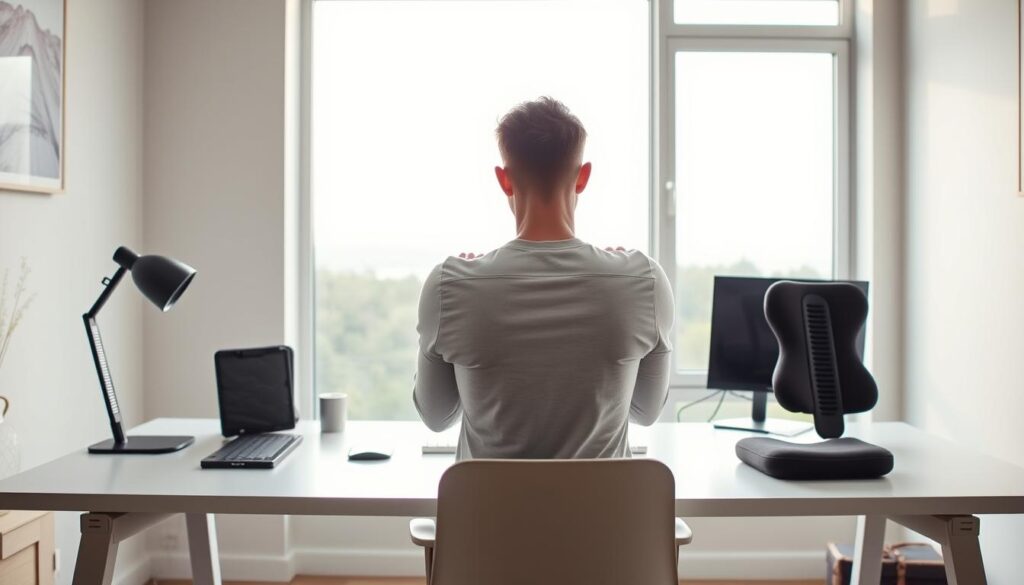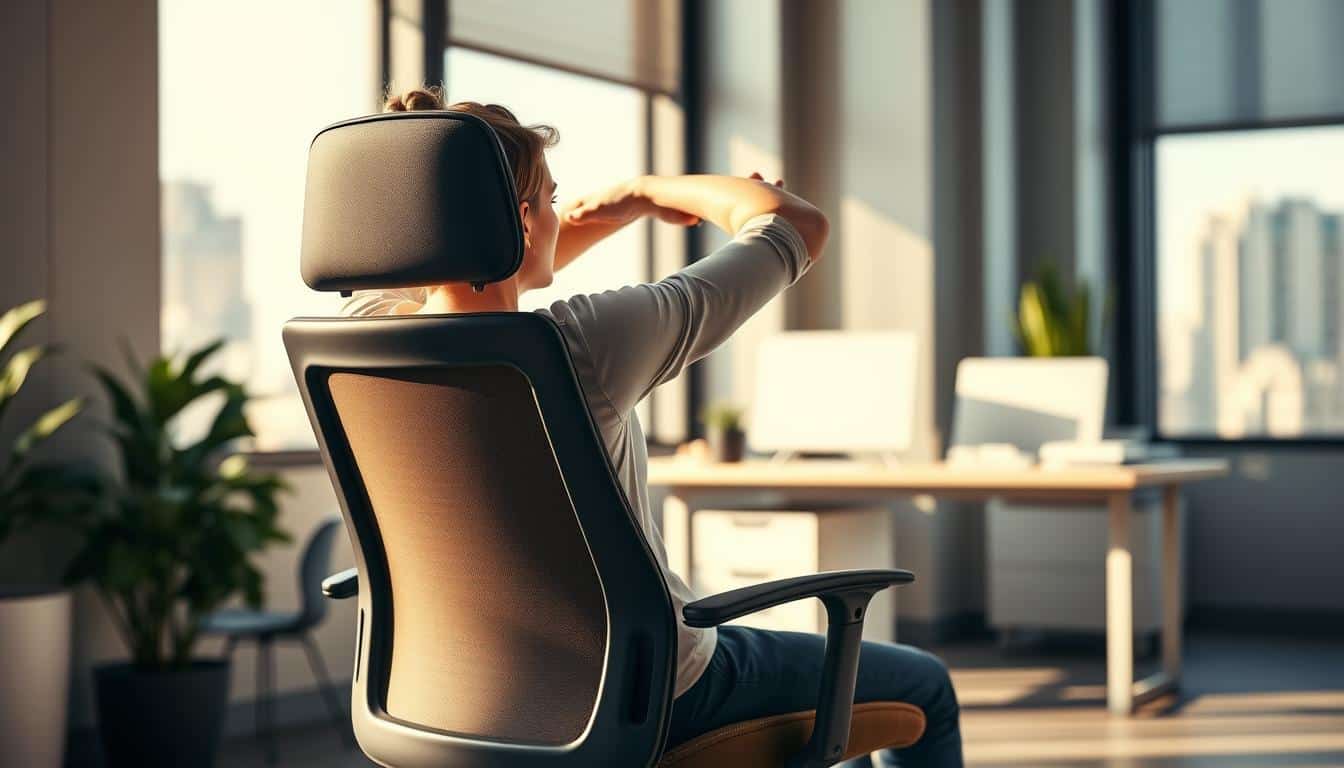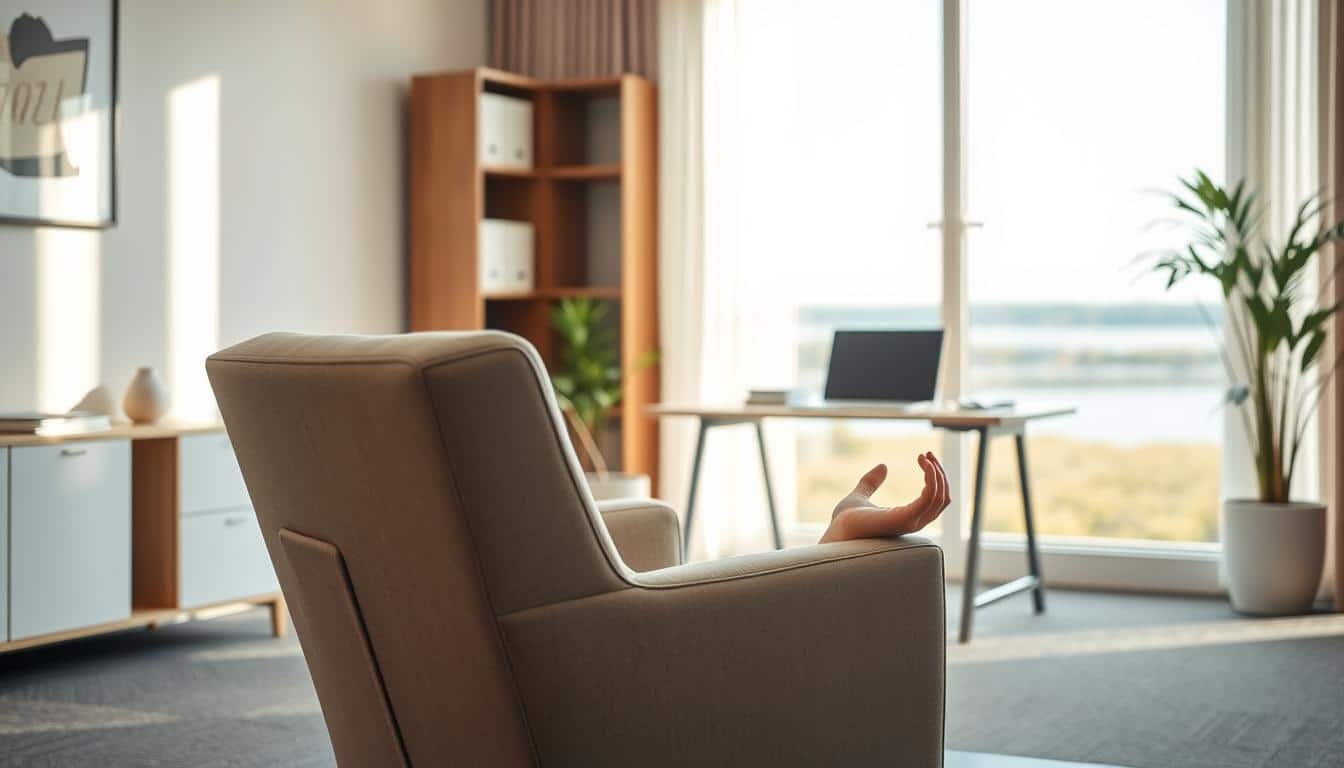Back pain is common for people with desk jobs. Studies show that 23% to 38% of desk workers feel this pain each year. With more people working from home, the problem has grown. Now, 41.2% of workers report having low back pain. We’ve gathered some quick tips to help desk workers relieve back pain. These simple steps can make a big difference in your comfort while working.
Understanding Back Pain Related to Desk Jobs
Understanding back pain from desk jobs means looking at what causes discomfort. Sitting too long puts more pressure on your spine, leading to pain. Pain from desk jobs can come from bad posture, like slouching or leaning over your keyboard.
This strains your back muscles and ligaments. Not having the right chair worsens the problem, causing more pain.
Doing the same movements, like typing, can make your lower back hurt too. This pain can stick around if you don’t fix it. Sitting all day can make your hip muscles tight, your glutes weak, and your core muscles lazy. This makes your back hurt more.
Studies show that back pain is a big reason people miss work. It shows how serious the problem is for those with desk jobs.
Murray Kovesy says sitting too much is like eating poorly. It’s bad for you in the long run. To fight this, try stretching often, setting up a good place to work, deal with stress, and move around more.
Make sure your chair supports your back well. Adjust your desk and monitor. These steps can really help avoid back pain.
Why Desk Workers Are Prone to Back Pain
Many people who work at desks often feel back pain. This is because they sit for long periods, sometimes more than 9 hours a day. Sitting like this puts a lot of pressure on the lower back. This can make the risk of lasting back pain go up a lot.
The reasons for this pain include bad posture and not setting up the work area right. Also, using the phone a lot can strain the neck and arms. About 65% of people working at desks get issues like back pain due to these things. For example, slouching can stretch the back too much and put pressure on the spine, causing pain.
Traditional ways to make workspaces better haven’t solved the problem. Even with ergonomic chairs and monitors set up well, comfort and pain prevention aren’t assured. Complaints about back pain increased a lot online during the pandemic. This is because sitting long can hurt the spine and muscles, making the pain worse.
It’s important for desk workers to pay attention to how they set up their workspace. Making changes can really help lower the chance of back pain. This leads to a healthier way of working.
Reduce Back Pain Desk Job
Focusing on two key areas is vital for tackling back pain from desk jobs: staying active and having an ergonomic workspace. Simple steps added to daily routines can greatly ease back pain. Using ergonomic setups improves comfort and encourages better posture, which helps people who sit a lot at work.
The Importance of Regular Movement
Moving regularly is essential for easing the ache from sitting too long. Taking short breaks every 30 minutes helps keep muscles from getting stiff. Here are some tips:
- Take breaks to stand or walk around to keep the muscles engaged.
- Change positions periodically to ensure blood circulation.
- Incorporate stretches or light exercises during breaks for flexibility.
Ergonomic Workspace Setup
Building an ergonomic workspace is crucial for good posture and reducing the risk of back pain. Important features of an ergonomic setup are:
- Adjust your chair for lumbar support and maintain feet flat on the floor.
- Keep your computer monitor at eye level to avoid neck strain.
- Ensure your elbows are at a 90-degree angle relative to your desk.
- Use a lumbar roll or towel for lower back support to maintain spinal alignment.
Arranging your workspace properly can lessen back pain, increase productivity, and improve overall health.
Create an Ergonomic Workstation
Creating an ergonomic workstation is key to cutting down back pain and boosting work output. You should choose the right chair and set up your desk correctly. Paying attention to small details helps keep you comfortable and efficient all day.
Chair Selection and Lumbar Support
It’s critical to pick a chair with good lumbar support for an ergonomic setup. This support keeps the natural curve of your back and allows you to sit for long periods without discomfort. Adjust the chair so your feet are flat on the ground. If needed, use a footrest. Your thighs should be level with the floor, and your knees should make a right angle to lessen leg strain.
Monitor Positioning and Desk Height
Setting your monitor correctly is crucial to avoid neck pain. It should be right in front of you, about an arm’s length away. The top of the monitor needs to be at or just below your eye level. This helps you keep your neck in a natural position. Make sure your desk is at a height that lets your elbows bend at a 90-degree angle while typing. Keep your keyboard and mouse close to prevent stretching. You might also want to try an ergonomic keyboard to keep your wrists straight.
The Role of Good Posture
Good posture is crucial, especially for people with desk jobs. Most U.S. jobs are sedentary, making it important to know how posture affects back pain. Bad posture at a desk can mess up your spine and press on discs, causing pain. Good posture means spreading your weight evenly to lessen strain on your body.
Setting up a workspace right is key to keeping good posture. This means placing your monitor, keyboard, and chair correctly to sit straight. Chairs that support your lower back are best. A lumbar support pillow can also help with back alignment and ease strain. Make sure your chair height lets your knees bend at a 90-degree angle to stay comfy.
Taking breaks to stretch can help maintain spine health in the long run. Knowing how posture affects back pain can ease discomfort and boost confidence and happiness. Studies show that bad posture increases the risk of pain by 40%. So, paying attention to posture at work can make you healthier and more effective.
Simple Stretches to Alleviate Tension
Adding simple stretches to your workday can really boost your comfort and ease tension. If you sit at a desk all day, doing stretches for your back is key. These moves help with neck and shoulder pain, increase your flexibility, and get your blood flowing.
Neck and Shoulder Stretches
Begin with stretches for your neck and shoulders to ease upper body tightness. Here are some good ones:
- Overhead Shoulder Stretch: Stand straight, lift one arm up, and push gently with the other hand. Keep this pose for 5 seconds on each side.
- Neck and Chest Stretch: Sit tall, weave your fingers behind your head, lean back, and gently sway. This feels great.
- Shoulder Shrug: Lift your shoulders up towards your ears, then let them fall. Do this 10 times for relief.
- Neck Stretch: Let your head drop forward, then roll it to one side and hold for 10 seconds. Do the other side, then rest a moment in the middle.
Upper and Lower Back Exercises
Now, let’s work on the upper and lower back to keep them moving well:
- Seated Cat-Cow: Sitting down, place your hands on your knees. Arch and round your back, breathing smoothly.
- Standing Backbend: Stand up, lock fingers behind you, bend back and look up. Hold for about 5 seconds.
- Hamstrings Stretch: Straighten one leg, rest your foot on a chair, and lean forward. Keep it for 10 to 30 seconds, then switch.
- Seated Spinal Twist: Sitting, twist towards the arm on the chair back and hold. Do 10 to 30 seconds on each side.
Integrate Movement into Your Workday
Moving around during your workday boosts health and work output. Desk jobs can make you sit too much, leading to health issues. Simple steps like walking meetings or adjustable desks can make a huge difference daily.
Walking Meetings and Phone Calls
Walking meetings keep you active while you chat with coworkers. They spark creativity and teamwork and keep your blood flowing. While on calls, try walking around. This keeps your brain sharp, relaxes your muscles, and boosts your energy.
Using Sit-to-Stand Desks
Using desks that adjust from sitting to standing has lots of benefits. They help you move from sitting to standing and back, improving your posture and burning calories. Regularly changing your position can fight the downsides of sitting too long. It helps control blood sugar, lifts your health, and keeps your body flexible and muscles rested.
Desk Exercises to Relieve Back Pain
Adding exercises at your desk into your day can really change the game for those feeling sore from sitting a lot. Simple moves such as seated spinal twists, cat-cow stretches, and desk push-ups can really help ease back pain and boost your spine’s health. By doing these regularly, you keep your posture right and boost flexibility, which helps handle the pain from sitting jobs.
Seated Spinal Twist
Moving your lower back becomes easier with this exercise. To do a seated spinal twist, sit up tall and put one hand on your chair’s backrest. Twist gently to one side, stay there for 15-30 seconds, then switch. This stretch helps ease the tension from sitting too long.
Cat-Cow Stretch at Your Desk
The cat-cow stretch is simple to do while sitting. Start by arching your back, pulling your belly in (that’s the ‘cat’ part). Next, let your belly drop and chest lift, looking up (the ‘cow’ part). Do this 5-10 times, focusing on your breath and spine movement. This exercise is great for easing back pain.
Desk Push-Ups for Core Strength
Desk push-ups boost your core and upper body strength. Stand a bit away from your desk, hands on the edge, and do 10-12 push-ups. Keep your body straight from head to heels. This not only builds strength but also works your abs, supporting your back and easing discomfort.

Maximizing Breaks for Back Health
To keep your back in top shape, it’s key to take breaks during the workday. Aim for a 5 to 10-minute break each hour you’re at your desk. Use this time to stretch your hands, wrists, and shoulders with fist stretches and wrist bends.
Adding exercises like head glides, neck relaxers, and shoulder rolls to your breaks eases neck and shoulder pain. Back stretches, like side and middle/back stretches, and leg exercises, including ankle flexes, leg lifts, and hip stretches, help too. These movements are essential for better back health during work breaks.
Try taking quick breaks every 30 minutes to beat muscle fatigue and keep moving easily. If you use a standing desk, keep your belly button pulled toward your spine and tuck your hips. Standing on one foot on a stool at times also helps lessen back strain. Remember, don’t stretch too hard to stay safe and get the most from your stretches.
Consulting Professionals for Persistent Pain
Dealing with persistent back pain? It’s essential to seek help from experts. A physical therapist can check your specific situation. They’ll create a custom treatment plan for you. This may help improve how you move and lessen your pain.
Therapists use special exercises and treatments to help. There are many methods, from regular therapy to advanced techniques for managing pain.
Chiropractors and doctors can also help with long-term back problems. They often do tests and checkups to find the best treatment. This might include surgery like Anterior Cervical Discectomy and Fusion (ACDF).
Or, they may suggest other procedures such as Thoracic Fusion or Lumbar Spinal Stenosis. For those not wanting surgery, options like radiofrequency ablation could help a lot.
Suffering from constant back pain? Don’t wait to get help. Making the first move by talking to a professional can change how you manage your pain. It can really improve your life.
Preventing Future Back Pain
Preventing back pain means adopting habits that protect your back in the future. It’s important to keep good posture. Always stand and sit with your back straight, shoulders back, and feet flat.
Taking breaks from sitting is key to avoid pain. Try to stand and stretch every 30 minutes. Simple stretches, like touching your toes or raising your arms, can help.
Using the right way to lift things is important to avoid hurting your back. Always bend your knees and keep your back straight when lifting heavy stuff. This helps keep your back safe.
Strengthen your back muscles with exercises at least twice a week. Being active also helps keep your muscles strong and reduces injury risk. Yoga is great for improving flexibility and posture.
Keeping a healthy weight is also crucial for back health. Eating foods high in calcium and vitamin D strengthens bones. This can lower the chance of osteoporosis and back pain.
For the best back health, mix ergonomic solutions, exercise, and healthy living. These efforts will help prevent back pain, making your work environment more comfy.
Conclusion
In short, solving back pain from desk jobs is key for better health. This guide on back pain tips underlines the need for an ergonomic work area, adding movement during the day, and doing special stretches. By doing these things, people with desk jobs can feel better and work more efficiently.
A study found that people who made changes sat 1.5 hours less each day. They saw a 50% drop in their Oswestry Disability Index, while others saw only a 14% reduction. This shows that improving back health at work brings big benefits.
At the end, this guide reminds us to take steps like getting an ergonomic chair or taking breaks to stretch. By doing these regularly, desk workers can have a workday free of pain and more enjoyable.



